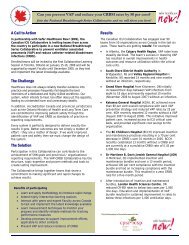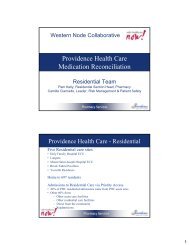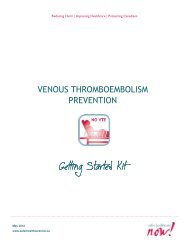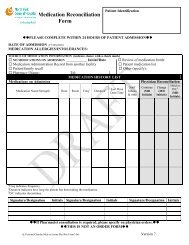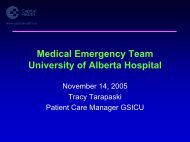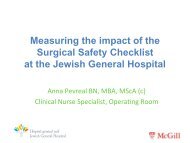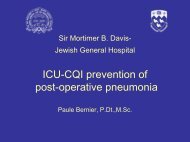VAP Getting Started Kit - Safer Healthcare Now!
VAP Getting Started Kit - Safer Healthcare Now!
VAP Getting Started Kit - Safer Healthcare Now!
Create successful ePaper yourself
Turn your PDF publications into a flip-book with our unique Google optimized e-Paper software.
<strong>Safer</strong> <strong>Healthcare</strong> <strong>Now</strong>! Prevent Ventilator Associated Pneumonia <strong>Getting</strong> <strong>Started</strong> <strong>Kit</strong><br />
increased costs, mortality and morbidity in ICU survivors. 155,156<br />
The most important step in delirium management is early recognition. This can support ICU<br />
teams by alerting them to changes in physiological status. The converse is particularly relevant,<br />
e.g. delays in identifying delirium may delay identification of important changes in critical<br />
illness, with its known consequences on patient outcome. In addition, the decision to initiate or<br />
titrate medications (for example, analgesia, sedation) depends on accurate assessment of<br />
delirium. Without appropriate cognitive status information, treatment will not match the needs<br />
of the patient. Three major delirium screening tools have been utilized - the Nursing Delirium<br />
Screening Scale, Confusion Assessment Method for the Intensive Care Unit (CAM-ICU) and<br />
Intensive Care Delirium Screening Checklist (ICDSC). Although the CAM-ICU and ICDSC vary in<br />
their approach - the CAM-ICU provides a yes-no syndrome recognition, whereas the ICDSC grades<br />
the syndrome to include a range of “subsyndromal delirium”, they have been validated in ICU<br />
patients and been successfully used in delirium screening and management. 157,158,159<br />
If delirium is detected, efforts should focus on identifying the cause, risk factors, and<br />
comorbidities which should then be minimized/or eliminated. 160,161,162 This is aided by the<br />
combined application of the other interventions (“ABC” and “E”) described in this Section of the<br />
<strong>VAP</strong> Get <strong>Started</strong> <strong>Kit</strong>. When these efforts are unsuccessful patients are treated with psychoactive<br />
medications. Unfortunately the pharmacologic management of delirium is far from<br />
straightforward, and in need of much work to improve our understanding of this syndrome and<br />
its response to various medications.<br />
Early Exercise<br />
The first trial reporting the results of a progressive mobilization protocol in ventilated ICU<br />
patients proved the principle that it could be performed safely with successful outcomes. 163<br />
After major organ (neurological and cardio-respiratory) stability was established, the<br />
investigators assessed protocol readiness. With increasing level of consciousness and strength,<br />
the level of mobility is progressed thus: physiotherapy is introduced, the first target being the<br />
sitting position in bed. Sitting on the edge of the bed is then attempted once the patient can<br />
move his arm against gravity; active transfer to the chair (out of bed) is then attempted once<br />
the patient can move his leg against gravity. Ambulation is the last target. 164,165<br />
Two other studies followed which strengthened this notion and recognized the negative role of<br />
sedation on neuromuscular performance and mobility. Schweickert paired SATs and SBTs (see<br />
page 15 - <strong>VAP</strong> Bundle Section “DAILY EVALUATION OF READINESS FOR EXTUBATION”) with early<br />
exercise and mobilization(physical and occupational therapy) in mechanically ventilated<br />
patients. 60 Patients randomized to the early mobility group were three times more likely to<br />
return to independent functional status at hospital discharge (primary endpoint, 59% vs.35%,<br />
p=0·02), had a shorter duration of delirium (median 2 vs. 4 days p=0·02) and more days<br />
breathing without assistance (24 vs.21 ventilator-free days, p=0·05). Furthermore, intervention<br />
patients had higher functional scores (p=0·05) at hospital discharge and ambulated greater<br />
distances without assistance (33 vs.0 m, p=0·004) than did those in the control group. These<br />
observations indicate that early mobility is well tolerated and feasible, decreases both ICU and<br />
hospital length of stay and improves functional outcomes at hospital discharge.<br />
June 2012 30



